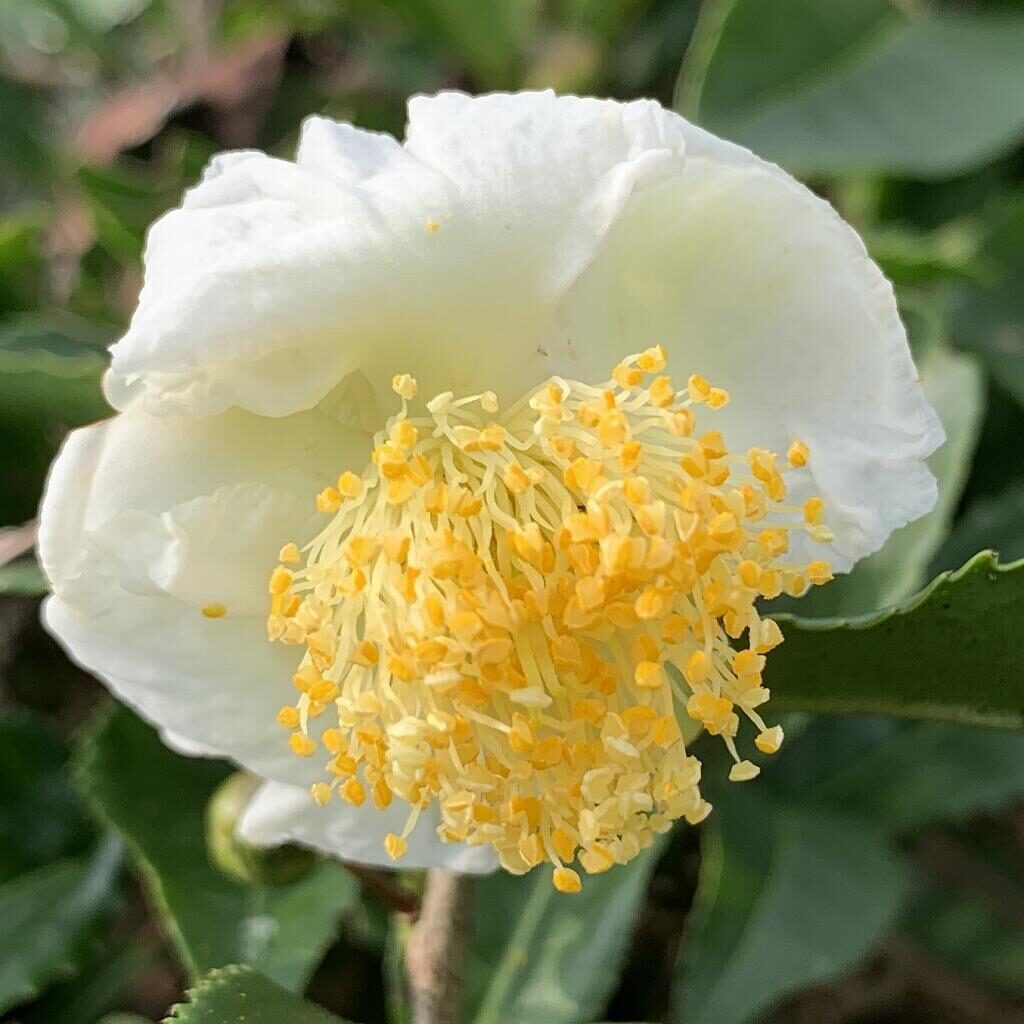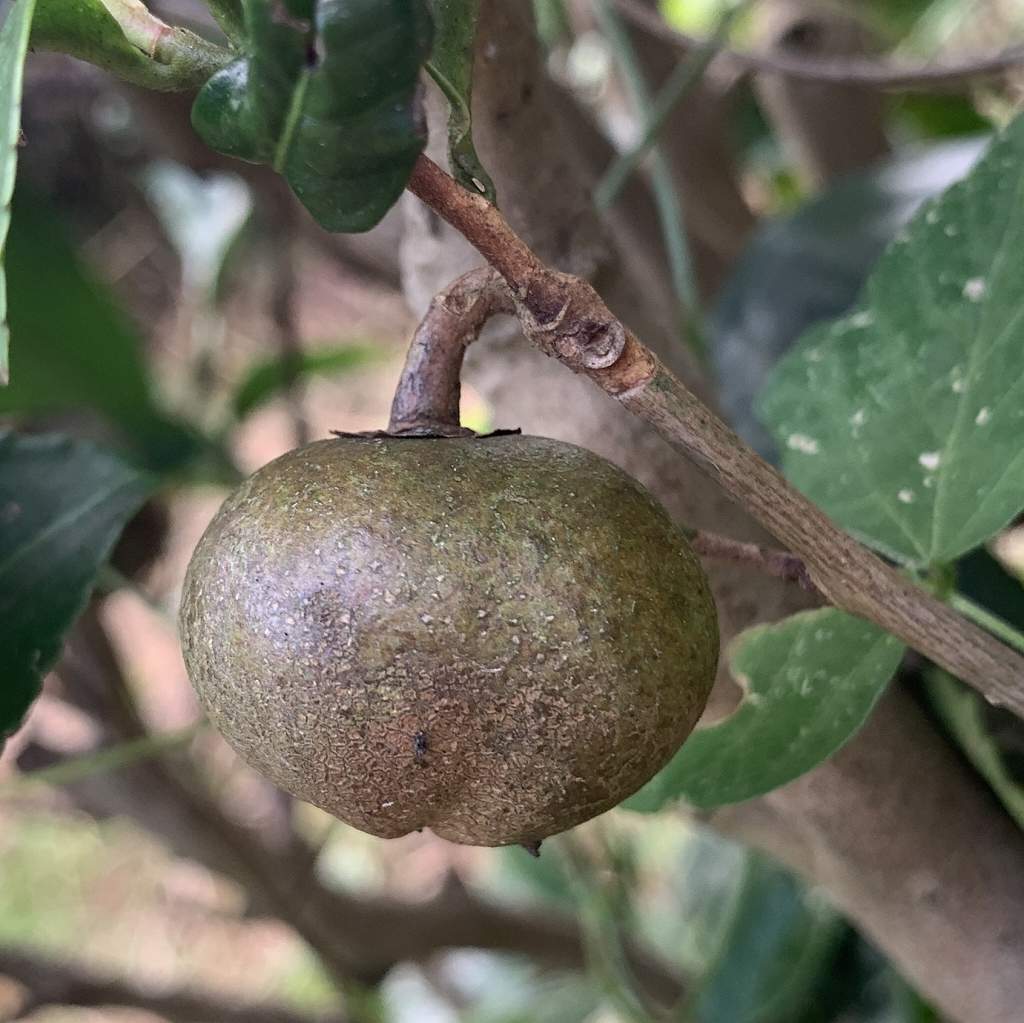チャノキは自然状態なら高さ数mになる木を刈り込み、1m前後で栽培。花は下を向いて咲き、白色の花弁より、黄色の雄しべが目立ちます。
Tea Plants are cultivated at around 1 meter by pruning trees that would be several meters high under natural conditions. The flower blooms facing downward and the yellow stamens are more prominent than the white petals.
【仮名】チャノキ, チャ
【和名】茶の木, 茶
【英名】Tea Plant, Tea
【学名】Camellia sinensis
【誕生】11/ 11, 12/ 08
【開花】09, 10, 11月
【花色】White, Yellow



チャノキ
チャノキの来歴
チャノキはツバキ科の常緑樹です。原産地は中国からベトナム、インドまで諸説あり、古くに栽培作物として世界中へ拡大。もともと気温が高く肥沃なところを好む陽樹ですが、改良により他の作物が育ちにくい低温・低日照、酸性土壌にも耐えられます。花言葉は「純愛」「追憶」。
チャノキの名前
チャノキの日本への伝来は、奈良時代から平安時代にかけて中国から。漢名「茶」の音読みから「チャ」になりました。鎌倉時代に喫茶の習慣や茶道が広がるとともに、各地に茶産地も形成。林縁などで見られる「山茶」は栽培種が逸出して野生化したもので、自生種ではありません。
チャノキの姿形
チャノキは自然状態なら高さ数mになる木を刈り込み、1m前後で栽培。葉は互生し、楕円状の披針形で縁に鋸歯が入り、革質で薄く、表面に艶があります。花は下を向いて咲き、花弁が白色で5枚、雄しべが黄色で多数、雌しべの花柱が3裂。花後は暗褐色で球形の蒴果を結びます。
チャノキの種類
チャノキは大きく2種類あります。中国の南部に自生する「シネンシス」は、木が大きくならないものの寒さに強く、丈夫な枝、短い茎、細長い葉。インドのアッサム地方に自生する「アッサミカ」は、熱帯から亜熱帯に由来するため、寒さや乾燥に弱いものの、葉が大きく多収です。
チャノキの利用
チャノキは、葉を蒸したり揉んだり煎るなどして飲用に。カフェインやタンニン、アミノ酸に富み、精油やビタミンC、フラボノイドを含みます。漢方では若葉が生薬「茶葉」として頭痛、下痢、食べ過ぎ、喉の渇きに。種子が生薬「茶子」として痰をともなう咳などに用いられます。
Tea Plant
History of Tea Plant
Tea Plant is an evergreen tree of the Theaceae family. There are various theories as to where it originated, from China to Vietnam to India. Originally, it prefers fertile, warm, and sunny locations, but through selective breeding, it can tolerate low temperatures, low sunshine, and acidic soil where other crops are difficult to grow. The language of flowers is “pure love” and “reminiscence”.
Name of Tea Plant
Tea Plants were introduced to Japan from China during the Nara and Heian periods. It became “cha” from the pronunciation of the Chinese name “tea”. In the Kamakura period, as the custom of drinking tea and the tea ceremony spread, tea production areas were formed in various places. The “mountain tea” that can be seen at the edge of the forest is a cultivated species that escaped and became wild, and is not a wild species.
Shape of Tea Plant
Tea Plants are cultivated at around 1 meter by pruning trees that would be several meters high under natural conditions. The leaves are alternate, oval-lanceolate with serrated margins, thin and leathery, and glossy on the surface. The flower blooms facing downward, and has 5 white petals, many yellow stamens, and a pistil with 3 cleft tips. After the flowers, dark brown and spherical capsules are formed.
Types of Tea Plant
There are two types of Tea Plant. Sinensis, which grows wild in the southern part of China, does not grow large, but is resistant to cold, has strong branches, short stems, and long thin leaves. Assamica, which grows naturally in the Assam region of India, originates from the tropics and subtropics, so although it is vulnerable to cold and dryness, it has large leaves and a high yield.
Use of Tea Plant
The leaves of the Tea Plant are steamed, rubbed, or roasted for drinking. Rich in caffeine, tannins and amino acids, it contains essential oils, vitamin C and flavonoids. In Chinese medicine, the young leaves are used as a crude drug called “tea leaves” to treat headaches, diarrhea, overeating, and thirst. The seeds are used as a crude drug “tea seeds” for coughs with phlegm.


